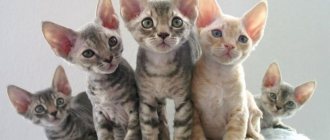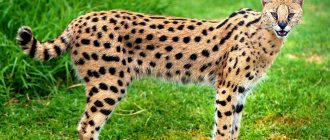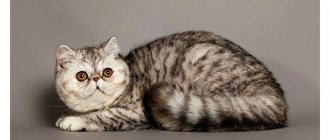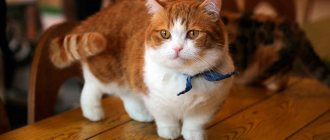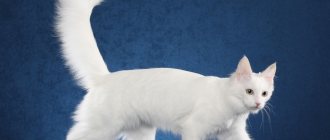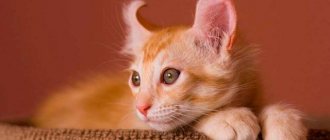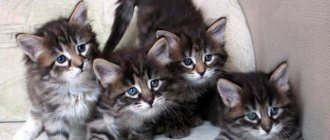Smoky color cats
Imagine that a black cat was suddenly covered in the bluish smoke of a burning fire, which penetrated into the depths of its fur, creating the complete impression that the animal was smoking. This is the smoky color. Of course, no one fumigates a cat with smoke, it’s just that the coloring of each hair is fixed in its genes, when only in its upper part it has a solid (usually black) color, and gradually becomes lighter from the middle to the base. The smoky colors of cats look especially beautiful on long hair.
Signs and superstitions
Cats have always been surrounded by a veil of mystery and mysticism. From time immemorial they were considered guides to the other world and were often accused of aiding sorcerers and witches. Therefore, it is not at all surprising that such unusual, rarely seen animals with a tortoiseshell color are considered mystical. There are many signs and superstitions in different countries, but they all have one thing in common - a cat with a tortoiseshell color is a symbol of good luck:
England. In this country, it is not customary to just give a tortoiseshell cat as a symbol of good luck and happiness. You must definitely give at least a small change for it, thus paying for further success, peace and love in the house. If a kitten with an unusual color comes into the house on its own, you also have to pay for happiness
At the intersection of 4 roads you need to put coins: it doesn’t matter what the amount is.
Russia. In this country, any cat, regardless of breed and coat color, brought happiness and peace to the house
In Ancient Rus', cats protected the house from evil spirits, protected from evil spirits and enemies. It was especially good if the color of the animal’s fur matched the color of the owner’s hair. Then peace, comfort and love always reigned in the house, and good luck favored the household. In this regard, tricolor cats were considered universal. There are so many shades combined in the color of their coat that they will suit any hair color.
Japan. In this country, cats are respected and loved by everyone, and animals with a tortoiseshell color are revered with greater honor. Figures with their image are placed near the entrance to each house, hoping that they will bring good luck. The Japanese prefer to have bobtails as pets, relying on the tortoiseshell color, because they protect the house and protect household members from evil spirits and bad thoughts of enemies.
Arab countries. In the East, cats are held in special esteem, and they are more preferred as pets than dogs. Tortoiseshell cats protect against adversity, fire and theft.
America. If in most countries tricolor cats are symbols of good luck, in America they are associated with money and material wealth. There is a belief in this country that if a tricolor cat comes to your house, it means that you can soon expect sudden enrichment. American bobtails are especially popular in the United States.
Also watch a video about tortoiseshell cats:
Cream
The cream color, which is the result of a dilution of the red gene, is found in a wide variety of varieties, from completely cream tabby cats to color-point beauties. It looks great on both short and long hair, and when the rays of the sun fall on an animal wearing such a coat, it appears pink.
Sometimes cream tabby cats are found in free populations, where there are many animals of red, in common parlance, ginger color.
Brilliant Californian
Brilliant California cats were bred by breeders as a result of numerous crossings of various pedigree cats. For 10 years, experts have been trying to get a pet that is visually similar to the royal cheetah, but without the admixture of wild blood, so for crossing they used only domestic cats of the American Shorthair, Angora, Siamese, British and Abyssinian breeds. The desired result was achieved in the 80s and the new cat breed was officially registered in the USA.
The appearance of the shiny Californian cats is as follows:
- large, muscular build;
- short, thick coat;
- large, slightly slanted eyes;
- small ears, rounded at the tips;
- elongated tail, dark at the end.
For shiny Californian cats, only one coat color is allowed, resembling leopard or jaguar. Cats of this breed are very sociable, active and good-natured. They treat strangers calmly and get along well with small children and other pets. An active pet needs long walks in the fresh air.
Faun
Looks like lilac, but is actually a lightened version of cinnamon, or cinnamon color. It is found in Abyssinian cats and has a light beige tint that can be compared to coastal river sand. You can read more about it in our article “Fawn color in Abyssinian cats.”
The most unusual solid colors
The unusualness of the colors listed below is explained either by their rarity due to their novelty, or by the difficulty of their inheritance. Because of this, not all of them are recognized by international felinological organizations.
Red (red)
The rarity in this case may seem absurd, because saffron milk caps are found everywhere: both among purebred representatives and among “nobles.” This is true, but with one caveat. If you look closely, almost all of these animals will have at least a tiny white spot or stripe pattern. Finding someone with a solid color among them is very, very difficult.
The problem of breeding completely red “mustaches” is explained by the following features:
- Mandatory presence of two parents with identical coat color.
- Constant development of the pattern: continuous, without spots. Achieved by blocking the non-agouti gene. Usually non-agouti interferes with the development of the pattern, but in ginger cats the body blocks it. As a result, the drawing appears when it shouldn’t.
- Sex-dependent inheritance of basic colors. Almost all saffron milk caps are cats. They account for 75%.
When breeding kittens, breeders specially select individuals with the widest red stripes. Due to their close location, the human eye perceives such a fur coat as monochromatic.
REFERENCE:
Agouti is the gene responsible for the appearance of the body pattern, or tabby. Non-agouti is a possible form, or allele, that has the opposite effect and inhibits the formation of the striped or spotted pattern. Only the O gene, characteristic of the red color, has immunity to this allele.
Cream
It is a lightened version of red and comes with the same breeding problems. It is even less common, since, in addition to the factors listed above, it requires the simultaneous presence of a special clarifier gene in both parents.
Apricot
The rarest option for coloring a fur coat is the red-yellow-orange color scheme. Achieved by lightening an already lightened color, that is, cream.
Chocolate
It appears due to a recessive gene that dilutes black. To breed kittens, both parents must be chocolate, but even then, the litter may produce babies with residual tabby stripes and grayish fur.
INTERESTING!
Most chocolate cats are artificially bred. The only exception is the “Abyssinians”.
Blue (gray)
Despite its prevalence, this color is still considered rare and noble. The appearance of a blue coat, as in the case of a chocolate coat, is caused by the dilution of black. It combines different shades of gray with full hair coloring.
Lilac or lilac
Bluish pink is a lighter version of blue. It is often confused with a faun, but if you know where to look, distinguishing a lilac is not that difficult. In the presence of lilac, the nose and paw pads have pronounced dark pigmentation with a lilac tint. With a faun, these areas are soft or beige-pink.
INTERESTING!
The most common iris among lilac cats is yellow.
Faun
This beige shade is reminiscent of sea sand or fawn. From a genetic point of view, it is a lightened version of Lilac. Faun is very difficult to breed and requires mandatory confirmation by DNA analysis.
Cinnamon
Cinnamon, or cinnamon, is a combination of chocolate with a hint of red. Like the faun, he was bred more recently by lightening his chocolate color and is also confirmed by a genetic test. It was first discovered among “Abyssinians,” but thanks to the efforts of breeders, British cats were also able to acquire a cinnamon coat.
Chinchilla
An extremely complex color, the genetics of which are not fully understood. Even experienced breeders who have been coloring for a long time have problems. With a chinchilla color, the base of the hairs is almost white, and the tips are colored in one of the usual colors. The whole secret is in the ratio of white and dyed, that is, where in the hair the transition begins. This is what determines whether the animal will look as magical as in these photos.
You won’t find chinchillas among outbred cats, but there are such animals in nature. The rodent that gave the color its name, without any effort from the breeders, has a coat of such a rare color.
Larisa Solodovnikova
The most unusual colors with patterns
The rarest cat colors are not always solid colors. Among them there are also options with a pattern, including silver, a haze effect, the presence of stripes, spots and other unusual features.
Tortoiseshell
It occurs very often, but not in cats. This is explained by the order of its inheritance. For the tortoiseshell color to appear, two X chromosomes with the genes for red and black color are required. In males this is genetically impossible, because normally their genotype (individual set of genes) looks like XY. Despite this, turtle cats are still born as a result of genetic abnormalities.
There is 1 cat for every 3 thousand tortoiseshell cats. Such animals are born as a result of a genetic abnormality and have a unique combination of genes: XXY or XYXY. The first option is more common and is accompanied by infertility, while the rarer second option retains the ability to reproduce.
Chinchilla, or veiled
Very often this color is mistakenly called the breed. In fact, chinchillas are found in several representatives at once: “British”, “Scots”, “exotics” and “Persians”.
In chinchilla cats, the coloring pigment remains only on the tips of the hairs, and most of them remain white. A golden color option is also possible, characterized by the presence of a soft apricot undercoat.
Silver tabby
Included in the group of silver colors along with chinchilla, haze and shaded. Despite the complex name, this species is familiar to many thanks to the kitten from the Whiskas advertisement.
In addition to the main silver tone, any pattern characteristic of a tabby appears on the body of cats: spots, marble, stripes or ticking (zonal hair coloring). The pattern may change as they grow older, so it is not recommended to adopt such kittens at too early an age.
Cameo
Formed in the silver group during a genetic failure. It is given by the abundance of pheomelanin, a special pigment responsible for the red-yellow-orange color spectrum. When dyeing cameo, the base of the hairs remains white, but the dark tips turn into light ones.
Gold
This color is unique in that it does not contain dark shades. As in the case of silver, staining occurs zonally. The difference is that in both zones the red tint remains, but in the top (at the tips) its brightness and intensity increases sharply. If the top layer accounts for ⅓ of the hair, then the color is called shaded gold, and if ⅛, then veiled.
The reason for the inheritance of this amazing color in cats is still being studied. Because of this, breeders do not always get the desired result and sell successful kittens at an inflated price.
Sepia
Included in the group of acromelanistic, or heat-dependent, colors. Unlike the closely related color point, sepia involves minimal contrast between dark markings and a light body. The transition between colors is almost invisible and resembles watercolor stains.
The darkest areas, or points, are formed where the minimum body temperature is reached: on the head, ears, tail and paws. Another distinctive feature of sepia is the cat’s golden-green eyes.
Mink
A more contrasting version of sepia, close to color point. In addition to contrast, eye color is also important here. In mink cats it is either golden blue or turquoise.
Important Note
If you want to get a cat of a rare color, remember: the fur of kittens changes after birth. You can understand what shade a cat will be only after six months, and sometimes even after a year and a half.
Therefore, when buying a small kitten, you do not yet see its color in all its glory. Sometimes this becomes a reason for fraud by unscrupulous breeders. Therefore, buy kittens only from professional nurseries.
Experienced breeders will be more likely to predict what the color of an adult individual will be, and you can really become the owner of a cat that is rare in color.
Scottish lop-eared
Interest in this cat primarily arises from its original ears, the shells of which are unusually and unusually bent forward. The Scots got this ear structure thanks to a mutation. The first such rare cat in the world was seen by people in 1961.
Her country of origin is Scotland. They have a lot of positive qualities. Cats are distinguished by their insightful mind, balance, and playfulness. They easily find a common language with everyone around them.
Their uniqueness is manifested in the originality of their voice. They do not purr or meow like most of their relatives. These sounds are more creaky. The owners of these pets are captivated and make them smile by their ability to stand on their hind legs.
They can stand on them for a long time, looking at what interests them. They are also distinguished by an interesting body position during rest. Cats sit with their back straight and their legs extended. This pose is called the Buddha pose. These cats can be purchased for $200-$1400.
Sokoke
This is the rarest cat in the world, bred not by breeders, but by nature. Its homeland is Kenya. Cats have medium, athletic shapes. They are graceful and elegant.
The pets' fur is short with an interesting color of gray-black tones. They are infinitely devoted to their owner and love to accompany him everywhere. They are playful and even too active.
They do not require close attention and are able to come up with activities for themselves. Moving and changing owners is too painful. They love children and are too tolerant of their possible antics. These amazing cats can cost between $500 and $1,500.
look at photos of rare cats endlessly. Their grace, tenderness and beauty seeps through the photograph. Once you touch your pet in real life, hear its monotonous and soothing purr, and you don’t need anything else.
Half an hour of communication with such a four-legged friend makes you forget about all the troubles and things that have accumulated over the whole day, and get real relaxation. Cats not only lift your spirits, but also heal and relieve stress.
Khao-mani
The breed is ancient, but quite rare. Having such a cat in your home is considered great luck. The breed received its second name Diamond Eye (diamond eye) for the beautiful color of the iris. The eyes of these cats are blue, green, amber and multi-colored. Snow-white pets with eyes of different colors look especially impressive.
Kao-mani are friendly, social animals. For a happy life, they vitally need communication with their own kind. The owners of such a pet must take care of other pets with whom the cats will spend time. Cats have a hard time with loneliness and without company they become depressed and aggressive.
Price
There are no breed nurseries in Russia and Ukraine. You can buy a kitten abroad or from private breeders. The cost of kittens starts from 80,000 rubles.
Korat
Korat is a cat with a charming blue coat and olive green eyes. The second name of this purr is Si-Sawat, as she is called in her homeland, Thailand. It was on those lands that ancient images from the 14th century were found, depicting these purring creatures.
In 1965, the breed reached a new level - official recognition by authoritative "cat" organizations in the USA.
The appearance of the cat is very captivating - the muzzle is heart-shaped, and the eyes stand out against the gray background of the fur, like two green lanterns. In general, Korats are small in size and do not weigh more than 5 kg. Gray-blue mustaches have excellent genetics. They are energetic, kind and affectionate towards other people and pets.
The cost of a korat depends on the pedigree and other characteristics. The color is of particular importance; the more shade of silver, the more expensive. The approximate cost of a small breed class purr is $500.
History of domestication of cats
The history of relations between humans and cats goes back several thousand years. Ancient chronicles and archaeological finds testify to this amazing neighborhood.
For a long period, scientists believed that the first who managed to domesticate cats were the ancient Egyptians. This conclusion was made after studying one tomb, which was built in 1950 BC. There were corresponding images on the wall paintings. However, studies of Cypriot burials in 2004 refuted these claims. The tomb, which dates back to about 9,500 BC, contained the remains of a man and a cat.
In ancient Egypt, these animals were given special attention. They were treasured because they helped people get rid of mouse infestations.
The Egyptians considered cats to be sacred animals. In the Middle Ages, attitudes towards them were ambiguous: in some countries cats symbolized kindness and tranquility in the home, while in others they were credited with magical properties and connections with evil spirits. Animals were especially widespread in some countries of Europe and North Africa, as well as in Russia, Japan and China.
In those ancient times, people did not attach much importance to cat breeds. This concept came into use about 200 years ago, when the rapid development of such a science as selection began.
On the territory of modern Russia, yard cats and cats appeared during the formation of Ancient Rus'. The breeding of purebred groups began only in the second half of the 18th century. In those years, the most popular breed was considered the Russian Blue, presumably bred in Great Britain.
York chocolate cat: rules for keeping a purebred kitten and care
- Grooming.
Since the York Chocolate Cat is the proud owner of a thick, long coat, it requires more serious care. In order for your pet’s fur to always look chic and well-groomed, it needs to be combed, and one procedure once a week will not be enough. The optimal frequency of brushing a York cat is approximately three to four times a week, and during the shedding period this procedure should be carried out daily, or even better, twice a day. To do this, it is best to use a medium-hard massage brush with medium-frequency teeth. Beauty is beauty, but do not forget that this is necessary, firstly, for the health of your four-legged friend, and, secondly, for the cleanliness of your home. If you do not rid your cat of dead hairs in time, then half of them will be on all surfaces of your home, and the other, predominant part will be in the animal’s stomach, which can lead to a lot of problems. But even if you scratch your cat three times a day, she will still have fur in her gastrointestinal tract and this needs to be dealt with. If your pet is on lawns, he can find the right “healing potion” for himself, but if not, then you need to make him such a “lawn” at home. For this purpose, pet stores sell seeds of a special grass that is good at removing fur from a cat’s stomach. In addition, you can periodically feed the purr with special vitamins for hair removal or food to which special substances are added. As for bathing, the Yorkie chocolate cat cannot be called an ardent fan of water, so you should not expose it to stress again. The cat needs to be bathed; if this cannot be avoided, it is optimal to do this once a season using high-quality shampoo. Air conditioning will also come in handy. - Hygiene.
York Chocolate Cat is very clean, but he cannot cope with some tasks without your help. Once a week they need to clean the external auditory canal, as a large amount of earwax, dust particles and dead epidermis can accumulate there. If this is not done, then these products clog the ear canal and little by little the animal develops hearing loss, which can lead to total hearing loss. Cats need to have their teeth brushed, as plaque very quickly turns into tartar, which leads to dental disease and tooth loss, which significantly worsens the quality of life of your pet. To carry out this procedure, you need to arm yourself with a special toothbrush and a cleaning agent, this can be either cat toothpaste or powder. When brushing your teeth, it is recommended to carefully clean your gums, but this is extremely difficult to do with a brush. In this case, you need to wrap a piece of thick, clean cloth (lint-free) around your index finger and thoroughly clean the cat’s oral cavity. Animals must be taught all hygiene procedures from early childhood, so they will not experience so much stress. - What to feed?
Yorkie Chocolate cats are not picky when it comes to food, so the choice is yours. If the food is purchased, then it should be of high quality, premium or super premium; it is better to combine dry food and canned food. Natural homemade food consists of lean meats, offal, chicken eggs, dairy products, cereals and vegetables. Fish is strictly prohibited. From time to time you need to add additional vitamin and mineral complexes to your home diet. Clean drinking water should also always be freely available for York Chocolate Cat, the main thing is not to give the cat raw water - either boiled or filtered.
Dwelf
The rare breed was the result of crossing three different breeds: the American Curl, the Canadian Sphynx and the Munchkin. The result of this selection is a cat with an original appearance, which at first glance seems repulsive. Completely hairless, the miniature breed has huge curled ears, a massive neck, a small wedge-shaped head, large slanted eyes and short legs.
Small hairless animals do not tolerate temperature changes well and are very thermophilic. The owners will have to take care of clothes for home and walking, constantly monitor the indoor climate, and prevent drafts. Delicate cat skin requires careful care; it is regularly wiped with damp wipes to cleanse it from sweat, grease, and dirt.
Price
In Russia – 135,000 – 180,000 rubles; in Ukraine – 50,000 – 70,000 UAH.
Elf
These handsome guys are quite young. They were first seen in America in 2006. To get such hairless pets, breeders had to work hard. Curls and Sphynxes took part in the painstaking work.
In addition to the fact that cats do not have hair, they have rather unique ears. Friendliness, intelligence, mischief, sociability, and curiosity are the main features of these pets. Elves are not a cheap pleasure. They cost at least 2000 dollars.
Elves got their name because of the ears that resemble those of fairy-tale characters.
